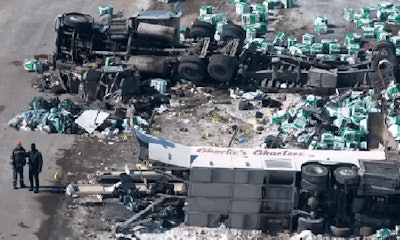
By Jeff Sanford
Toronto, Ontario — July 17, 2018 — The tragic collision in Humboldt, Saskatchewan this past spring is forcing important and overdue changes to this country’s trucking industry.
It was only April 6th of this year that the team bus for the Humboldt Broncos hockey team collided with a tractor trailer in Saskatchewan killing several members of the squad.
The accident made headlines across the country and quickly became a national tragedy.
Since then provincial politicians have scrambled to announce new regulations as public attention has revealed large and glaring gaps in the regulatory environment around the trucking industry.
Many were surprised to find that only the province of Ontario has a mandatory training program in place for truck drivers. That program only came into place last July after newspaper reports revealed dozens of unregulated truck-training schools, so-called “licensing mills”, were teaching students just enough to pass the certification test.
Now truck drivers in Ontario are required to complete a 103.5-hour course at a licensed school before they can be tested for a Class 1 license. In the wake of Humboldt other provinces are looking at the Ontario program.
As it is, many newspaper reporters in the western province have found that trucking industry insiders consider current tests, “a joke.” Stories have surfaced about instructors who quit the industry, overwhelmed by “frustration and guilt” about the fact the written and road exams to get a Class 1 license are far too easy.
As the “dirty secret” of the trucking industry has been publicized provincial transportation ministers have are hustling to announce changes in training and certification.
Alberta Transportation has announced that the privatized licensing system in that province will be revamped. Critics there say the system has devolved to one in which there is, basically, “no oversight at all.” Alberta has announced it will make all driving examiners government employees by January 2019. The province will also close a loophole that allows trucking companies to operate without a safety certificate. Truck drivers and school bus drivers will also have to take training courses, rather than simply pass a test, as is now the case.
The province will also scrap controversial “temporary 60-day safety certificates” that will eliminate what had been called “the chameleon carrier” regulatory loophole that allowed companies suspended for safety violations to simply switch names and then reopen for business.
Manitoba has also announced it will make changes to the regulatory regime around its trucking industry.
Oddly, it is Saskatchewan, the site of the accident, where government officials seem most confused about what to do. On April 25 the Saskatchewan Government Insurance (SGI) organization distributed a press release that noted plans for “mandatory Class 1 training,” for drivers of a semi-truck. But the next day SGI distributed a second memo stating that no decision had been made on the issue of driver training before a test. Provincial officials have since confirmed that the province will introduce standardized training course for drivers in 2019.
Interestingly the Canadian Trucking Alliance (CTA) seems to think the regulations don’t go far enough. Just this past week the CTA released what it is calling a ten point “Action Plan to Raise the Bar for Truck Safety.” The plan suggests new regulations that go much further than the requirements provincial officials are discussing so far. In fact, the CTA recommendations would see a remarkable expansion of ADAS systems on trucks.
The points are as follow:
Introduce regulations this summer to mandate the use of electronic logging devices (ELDs) for all carriers required to maintain a logbook by September-December 2019.
Consult with the Federal Government, commercial vehicle manufacturing and trucking industry to explore the feasibility of developing regulations requiring the installation of forward-facing cameras in all new and existing federally-regulated commercial vehicles.
Partner with governments, manufacturers and the trucking industry to assess the availability and feasibility of increasing the use of additional in-cab technologies that monitor distracted driving behaviour of commercial drivers.
Begin working with the governments, manufacturing and the trucking industry to assess the market readiness of advanced driver assist systems (ADAS), including speed limiters to mandate set speeds on heavy trucks, and determine the role governments can play in increasing the penetration rate of driver assist technology in the marketplace.
Encourage all provinces to introduce mandatory entry-level training (MELT) for commercial truck drivers based on the national occupational standard (NOS).
Work with governments, trucking and the training industry to develop a distracted driving awareness module for commercial vehicle drivers to be incorporated into all provincial MELT programs and other training programs.
Explore with the provinces and the federal government ways to expand the use of on-road safety prescreening technology (pre-clearance/pre-screening) to assist provincial enforcement officials in identifying commercial vehicle operators that require further attention and intervention.
Work with federal and provincial governments to better focus on-road enforcement related to known human factors that contribute to collisions.
Work with federal and provincial governments to develop a better proactive system to identify trucking companies and drivers that pose a risk to public safety including such measures as mandatory drug and alcohol testing, new entrant education and evaluation programs and anti-avoidance mechanisms.
Work with federal and provincial governments to develop a ‘best practices’ guide to assist purchasers of transportation services in identifying unsafe operators.
The original document can be found here, https://bit.ly/2NLf0Qq























